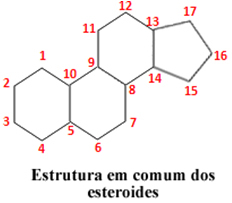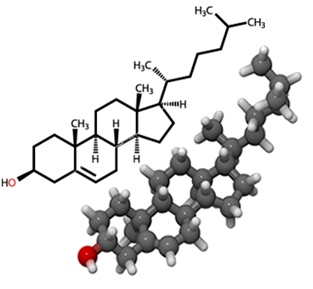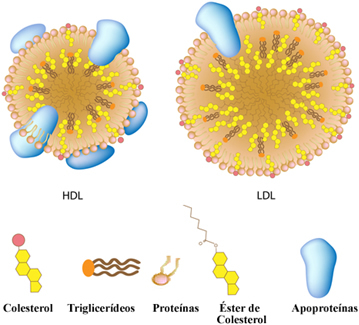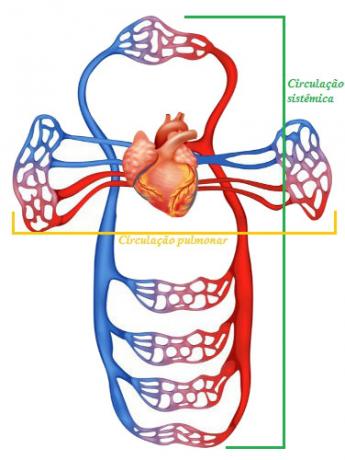You lipids they are a class that encompasses all fatty substances existing in both the animal and vegetable kingdoms. Hence the origin of the term, as it comes from the Greek lipos, which means “fat”.
Among the best known lipids are the steroids (from the greek stereos, which means "solid", and eidos, which is “similar”). Steroids are all compounds that have in common the same structure as a hydrocarbon with 17 carbon atoms linked in the form of four cycles, as shown below:

The difference is that each steroid has a type of organic functional group attached to this structure. The most important steroid for the human body and also the most abundant in the animal kingdom is cholesterol. As can be seen from its structural formula below, cholesterol has a hydroxyl linked to the characteristic group of steroids and, due to this, it is also classified as a alcohol (secondary and monounsaturated):

Cholesterol is very important for the human body because it participates in cell membrane synthesis, in the production of vitamin D and the female and male sex hormones, which are respectively estradiol and testosterone, which are also steroids.
The main procurement sources of cholesterol are foods of animal origin, such as eggs, bacon (smoked bacon), red meat, cream, butter and dairy products in general.

But cholesterol is also synthesized by our body, mainly in the liver and intestines. The more cholesterol that is consumed, the less cholesterol will be synthesized, and vice versa.
Medical tests usually indicate two types of cholesterol, which are commonly called “good” and “bad”. However, these two types of cholesterol are the same, there is only one structure for cholesterol. The difference is in the lipoproteins formed by cholesterol.
Cholesterol is insoluble in water and it needs to be transported from one tissue to another through blood, which is watery. So it is converted into lipoproteins, which are spherical structures that contain hydrophobic substances in their center, which do not dissolve in water, such as cholesterol and other lipids. These molecules are surrounded by proteins, which are hydrophilic, that is, they have an affinity for water and dissolve in it.

As you can see in the image above, depending on how cholesterol and other substances combine, two types of lipoproteins are formed, which are called “two types of cholesterol”, HDL and LDL. See the difference between the two:
- HDL (high density lipoproteins): Its density is between 1.063 and 1.210 g/mL, besides having only 2% of free cholesterol by mass. Of the total amount of cholesterol in our bodies, only 30% appears in this form of protein and they are transported from human tissues to the liver, where it is recycled or eliminated.
This is the "good cholesterol", as high levels of it are associated with a reduced risk of developing heart disease. To increase its level in our body, we must decrease the intake of animal fat, which is saturated, such as that found in red meat, dairy products and eggs, by polyunsaturated fats.
- LDL (Low Density Lipoproteins): Its density can range from 1.006 to 1.063 g/mL. It has 8% cholesterol free mass and 70% of the cholesterol in our body appears in this form of protein. It is transported by the blood from the liver to the peripheral cells of the body's tissues to be used in the aforementioned syntheses.
- This is the "bad cholesterol", because if there are high levels of this cholesterol in our blood, over time, it will be deposited on the walls of the arteries, which impedes the flow of blood to the tissues. This clogging of the arteries is called atherosclerosis. If this occurs in the coronary arteries, which are the arteries that supply the blood, the person is prone to heart attacks.

The average cholesterol level considered normal is 150 to 200 mg/mL of blood; values around 300/100 mL of blood can cause the mentioned problems.
By Jennifer Fogaça
Graduated in Chemistry
Source: Brazil School - https://brasilescola.uol.com.br/quimica/composicao-quimica-colesterol.htm

